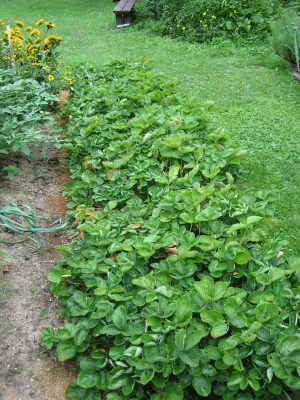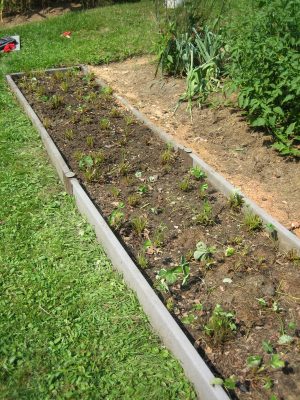By Dawn Pettinelli, UConn Home & Garden Education Center


So, you decided to grow some strawberries this year. You carefully prepared the bed and have enjoyed your first crop. Now you are wondering what to do to keep your strawberry bed healthy and productive. In part, the care after harvest depends on whether you are growing June bearing or day neutral (everbearing) varieties and what kind of row systems you have them planted in.
June bearing strawberries are most commonly grown in what is known as the matted row system. Mother plants are set 18 to 24 inches apart in 3 to 4 1/2 foot rows and runners are allowed to root anywhere within the row. This system is usually the easiest to maintain. Typically, at the end of the third growing season both plant quality and fruit quantity start to decrease and the whole bed is dug up and replanted with new disease-free strawberry plants. Try to incorporate this into your garden rotation plan to reduce disease problems.
June bearers can also be grown in single rows composed of different aged plants with the original plants set about a foot apart. A second row is started with first year runners and set 18 inches from the initial planting. Use only the first or second daughter plants produced along the runners because they are the most vigorous and productive. The rest are usually discarded.
The next year a third row is made again using the first one or two daughter plants and once more surplus runners and plants are removed. After the original mother plants have produced fruit for about 3 years, they are generally replaced with new, disease-free stock and the cycle continues. This way one always has a row or two of strawberries in production. Ideally the row with the new strawberry plants should be located on a section of the garden where strawberries haven’t been grown for 3 to 5 years. This isn’t always possible in small yards, which is why it is important to purchase certified virus free stock.
After year two when June bearing strawberries have finished producing their crop, it is time to renovate. According to Evan Lentz, UConn Fruit Specialist and Assistant Extension Educator, renovating your June-bearing strawberries is one of the best ways to maximize your annual production, reduce disease instance, and maintain an orderly planting. Proper renovation ensures that you set yourself up for success in the following year and allows you to extend the life and productivity of this semi-perennial crop. This is doubly important for individuals producing fruit in an organic or no-spray system.
This can be done sometime in July through August. Lentz suggests starting by either mowing or clipping with hand trimmers all the foliage about 2 inches or so above the crowns. Next, go through the bed removing all weeds, and weak and extra strawberry plants and dead or dying leaves. Thin to space plants at least 10 to 12 inches apart and cultivate around these remaining plants.
Now is the time to fertilize your strawberries whether beds are renovated or not. Lentz recommends working in about 3 to 4 pounds of 10-10-10 or its organic equivalent per 100 square feet. Lightly scratch the fertilizer into the soil. Brush or rinse any fertilizer off leaves at the salts will injure them.
Day neutrals, such as ‘Tristar’, ‘Seascape’ and ‘Mara des Bois’ produce a fairly decent size crop in June and continue forming occasional berries until frost. Unlike June bearers which develop fruit buds in late summer and early fall, the ever bearers have the ability to form fruit buds throughout the summer. An advantage to growing day neutrals is you will still get strawberries even if a late spring frost kills their initial fruit buds.
In general, day neutrals are grown for 2 or 3 years and then a new batch of strawberries is planted. The day neutrals produce far fewer runners than the June bearers. The new daughter plants should all be removed although they can be transplanted into another area if desired. Plants are usually set one foot apart in single rows about 18 inches wide.
According to Lentz, all strawberries require at least an inch of water per week for vigorous growth. If dry weather sets in, plan on irrigating plants, especially those just renovated. Use a mulch of pine needles, straw or wood shavings to conserve moisture, keep weeds down and berries off the soil. Since strawberries are shallow rooted, it is important to keep weeds under control.
It does take a little time to maintain a strawberry bed but the luxury of picking your own berries for strawberry shortcake, jam or fresh eating makes it all worthwhile. If you have questions about growing strawberries or on any other home or garden topic, contact the UCONN Home & Garden Education Center, toll-free, at (877) 486-6271, visit their web site at www.homegarden.cahnr.uconn.edu or contact your local Cooperative Extension Center.